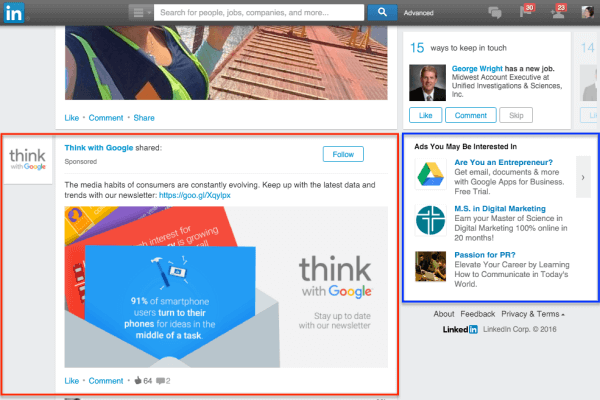Social advertising has quickly become an integral part of a complete digital marketing strategy. In the recent 2016 edition of The State Of PPC, this sentiment is supported by 65% of brands and 83% of agencies who tout social advertising as the most important aspect of the digital marketing industry over the past 12 months. From Facebook to Twitter, Instagram to Snapchat, social advertising boasts an unparalleled reach while offering targeting tactics unknown to traditional search.
While often representing a strong brand awareness play for big brands and retail, the value of social certainly extends to B2B clients. With advertising personas built on a combination of user behavior and self-identified traits, specific yet significant audiences can be targeted with a high degree of confidence. In this sense, Facebook certainly remains the strongest option from a volume perspective. Despite this, LinkedIn provides an extremely effective option for reaching your target audience in a professional setting.
Ultimately, there is no denying the inherent obstacles of B2B pay per click marketing. With 106 million monthly active users including roughly 9% of Americans active during work hours, LinkedIn provides an impressive array of solutions to these challenges. Although playing second fiddle to the social giants, over 32% of advertisers expect to increase their budgets on LinkedIn over the next 12 months. During that same time period, it is safe to expect some major developments to the platform following its acquisition by Microsoft. With this in mind, we’ve outlined a complete beginners guide that will help you tap into the potential of LinkedIn ads.
Finding The Right Fit
[bctt tweet=”Simply put, LinkedIn Ads are expensive. But with the right client and intelligent targeting, returns can both match and supplement search campaigns.” username=”Will_Larcom”]
Before launching a single ad it is vital to ensure your account is a sensical match for LinkedIn. While the platform offers unique targeting options, the average LinkedIn user spends only 17 minutes a week on the site. This means that engagement windows are low with an inventory severely limited compared to that of other social networks. In order to ensure there is value in such an investment, self-select after meeting the following requirements:
- Available Budget – LinkedIn is a true asset for clients seeking highly targeted expansion.
- High Funnel Expectations – Like all non-retargeting display advertising, LinkedIn taps into a cold audience. With that said, it is a highly qualified, highly relevant, top of the funnel crowd.
- Customer Base Is Consistent With LinkedIn’s Users – Business to business clients generally make the most natural pairing. If you sell glitter bombs to prank seeking teens, this isn’t the platform for you.
Simply put, LinkedIn is expensive. But with the right client and intelligent targeting, returns can both match and supplement search campaigns.
Account Access
Once you’ve determined that your vertical is compatible with the LinkedIn audience, it’s time to start running ads. Companies starting off fresh will need to create a company page and business advertising profile here.

If you are an account manager or agency, you’ll need to be granted advertising access to the client’s page as a campaign manager. Keep in mind that there are unique permission settings for both text ads and sponsored posts which will come into play if you hope to capitalize on both ad types.
Interface
Once in the account, you’ll arrive at a fairly simple, yet serviceable interface. From the main page, you can toggle between active, paused, and archived campaigns while displaying all of the major engagement and impression related statistics. In order to update targeting, creative, or bids, you’ll need to select a specific campaign from the list provided.

Note the demographics tab shown in the image above. Selecting at the account or campaign level will provide analysis of the audience reached through your campaigns broken down by job title, job seniority, job function, company size, and location. Revisiting this data provides excellent insight on the success of your tactics along with revealing inefficiencies to be avoided later.
Ad Types
Upon creation of a new campaign, you’ll be prompted to choose between sponsored content or text ads. Fundamentally there is little difference between targeting options and setup of these two campaign types, however, the ads within them behave quite uniquely.
Text ads offer a 25 character headline, 75 character description, and a small image embedded directly to the left side of the ad. Given size limitations, most advertisers will choose to go with their company logo in this format. Text ads will be shown to the right side of a user’s feed much like the right-hand column within Facebook. Traditionally these ads offer large impression volume, but low engagement and limited direct clicks through to your website.

Sponsored posts frequently drive the lion’s share of traffic for a LinkedIn campaign. They appear within a user’s scrolling feed which provides a much more native feel. This dictates the needs for captivating, solution based ad copy that leans more informative than promotional. Sponsored posts grant the advertiser much more freedom with the creation process taking place in what feels similar to a Facebook status update.
The URL itself (tracking and all) will be embedded within your copy and automatically shortened. An article preview auto populates below the status in combination with a thumbnail. The image can be replaced by toggling through the supplied options or with an upload of your own. Pro tip: for more ad real estate and larger creative, delete the auto-generated thumbnail. Then proceed to select the small image embed button in the ad status box and re-upload your chosen creative.

Targeting
Audience creation is where LinkedIn sets itself apart as a platform. Targeting criteria can be layered in an extremely intentional and specific fashion. With that said, it’s imperative that your final audience isn’t too limited given the impression inventory of the platform and click-thru rates of text ads. The audience may be extremely qualified, but at its core LinkedIn remains a Display advertising network with an audience demonstrating fairly typical high funnel behavior.
Beyond geographic targeting, LinkedIn provides ample segments for directing ads shown below. Job seniority and years of experience are an excellent tool to limit large audiences in hopes of getting in front of decision makers. In contrast, member groups provide additional criteria for targeting professions or positions with a limited supply.

After creating an audience, templates can be saved for use in similar campaigns or to be revisited at a later time. This is a particularly useful feature when creating complimentary sponsored content and text ad campaigns.
Bids/Budget
The final step that remains before launching your first LinkedIn campaign is budget and bidding. For budgeting, I suggest following the 70-20-10 budget allocation method endorsed by PPC Hero’s very own Cassie Oumedian. In this system, 70% of the budget is devoted to tried and true tactics, 20% to safe bets, and 10% to experimental. In the case of a new LinkedIn marketer, the launch would begin with that 10% experimental portion.

Bidding within LinkedIn is simple. After creating an audience, a marketer will be supplied with suggested bid ranges for both CPC and CPM bidding based on the data of those targeting a similar audience. While bidding slightly lower than the suggested amount will still yield impression volume, an advertiser will have to remain competitive with these numbers in order to reach the majority of their audience.
Measuring Success
Determining what qualifies success in a LinkedIn campaign will drastically vary based on the client and audience. Fortunately, native conversion tracking within LinkedIn is now available and can be accessed by navigating to the tools tab in the upper right-hand corner of the interface. Instructions for tag implementation and setup are readily available in this section.
Beyond direct conversions, keep a keen eye on CPC, CPM, and engagement levels. Ultimately sponsored posts will likely drive the largest percentage of your LinkedIn traffic which makes them the most desirable candidate for in-depth testing of landing pages, ad copy, and creative. Don’t forget to connect LinkedIn to your remarketing efforts. A custom audience built around LinkedIn traffic within Analytics represents an extremely effective method for re-engaging with the same audience in a different ad space and at a cheaper cost.
Concluding Thoughts
LinkedIn advertising provides a truly expensive cost-per-click in comparison to other content and Display marketing. Unique targeting criteria invaluable for many business to business clients is the payoff. Despite costs, LinkedIn is an excellent match for marketers with a compatible audience, budget for experimentation, and a desire for high funnel expansion. Personally, I’ve found mixed results in my efforts with returns spanning from insufficient volume to campaigns that convert at a clip well beyond typical cold audience advertising. Please feel free to share your experience or feedback on Twitter to @ppchero or @Will_Larcom.
Cover photo courtesy of Jon Howard



